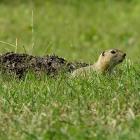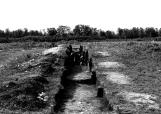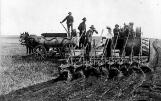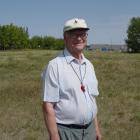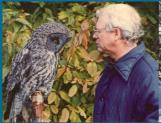2
...an opportunity to help, ah work at the new provincial museum, the Museum of Man and Nature, as head of the Natural History section and even got to hire our first botanist, Paul Rolston who worked here for a number of years. And at some point I stepped on the property that is now the Living Prairie Museum site and it looked like prairie to me. And, Doug Wade, as it happened, was in town briefly for a lecture which I cannot recall the details of. I invited Doug to come out and walk on that piece of property [dog barking in the background] with me. And he was enormously enthusiastic and convinced me that this was genuine prairie and it ought to be preserved. And I brought this to the attention of Dr. Jennifer Shay, professor at the University of Manitoba, a botanist of considerable note. She and Karen Johnson, who by then was the botanist at the Manitoba Museum, and they were searching for prairie throughout the province at that time. And in any case, ah I also got professor Joe Ellis, a retired professor of soils at the University of Manitoba, to come out. And he brought along a shovel and we dug 6 or 8 holes at different spots on the prairie. And he was convinced, looking at the soil profile, that basically this area had never been ploughed. And that just added further weight to the importance of this as a, a piece of rare habitat. Uncultivated, native, tall grass prairie that ought to be preserved.4
Richardson's ground squirrels. I don't know if you still have them, but ah, there were some.Yes, there are several.
I have a faint recollection that a burrowing owl may have been seen or reported, but I did not personally see it and that species is practically extirpated in Manitoba now, so there's no hope for that. But certainly bobolinks, western meadowlarks, king birds in that little remnant homestead, shelterbelt we mentioned. And a couple of oddities - what? A western king bird or two. Things that we would expect to find in an open grassy area even within the city limits. I can't off hand recall anything else; although, I take it somebody keeps a list of species that have been recorded on the site.
There is one there.
There would surely be meadow voles, and I would be surprised if there were not an occasional short-tailed shrew. That's a big one of my special interests.
6
I can recall giving an illustrated lecture using colour slides, mostly taken by Bob Taylor I suspect. Can you imagine? I gave a talk to the employees, during their lunch hour, at the Boeing plant which sits to the north. That was before the final boundaries of the Living Prairie Museum site had been designated. And I tried to convince the Boeing people - what I, what I talked to them about, was tall grass prairie. And they had some of it on their property. And I said instead of turning this into a bluegrass artificial lawn, nice as that is; why not preserve this northern section of the St. James prairie? And that didn't really work out because indeed they had to have parking lots; they had to have roadway and so on. But I can recall there was a fairly enthusiastic response to my presentation. And ah, there are still remnants of prairie, as you're aware to the north of the present Living Prairie site. Including the one a way to the west of the Boeing plant where there is, in fact, one of the very few aboriginal burial mounds. An historic Sioux burial mound that sits on very decent prairie. It needs to be restored, not the burial mound, but the surrounding site could be good prairie if, like your site, it were burned once in a while. Prairie needs to be burned once in a while to push back the invading species that tend to take over. But apart from that, I've always felt sorry that, I think that it was unfortunate, that that section of prairie had not been embraced within the boundaries of the Living Prairie Museum site and that burial mound ah, preserved and identified and designated. How many historic (inaudible)… It was looked at by an archaeologist at the Manitoba Museum and identified as an historic Sioux burial and it was a multiple burial with five or six individuals. So it's several hundred years old.8
Was it stressful?As I recall, there certainly was some opposition. People were concerned about what would happen. And when there was talk about the necessity to occasionally burn the prairie in order to maintain it at its best, yes there was concern. Ah, a slight amount of opposition that ah… I can't recall details. But we did talk to the media. And we had, as I recall, an article or two in the local press and there were certainly interviews on radio. And, ah, there may have even been some real-estate, but it seemed to me that there was an understanding by developers that much of that area is underlain by, if not bedrock, limestone. Some very massive, ah, pieces or sections of limestone. There are still some very large limestone boulders ah, here and there if not on your site, to the north of that site. An indication of the underlying bedrock or glacial debris that would have made digging basements, for example, extremely difficult. That may have been another reason why there was a minimal amount of disturbance. I don't really know that, but I suspect that.
9
Little girl handing over crocus to officials at the Living Prairie Museum's dedication ceremony.26 April 1974
2795 Ness Ave, Living Prairie Museum, St. James, Winnipeg, Manitoba, Canada
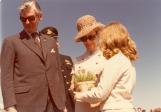
10
...city owned land, I could be wrong. And that it was just a matter of convincing the, ah, people in charge to designate this as a site that should not be developed for housing or any other purpose. That it should be maintained left as it was as an educational beauty spot that could be enjoyed by people. And the number of people who showed up at the dedication ceremony, what? Eighty or a hundred people. I just remember there was a large crowd. And the press was on hand and the mayor and some, somebody from government. And, the little girl who walked forward with a crocus flower in her hand to present to the chap who was officiating was a memorable moment. There were reporters, writers on hand; you must have already spoken to some other people who were there. It was an enthusiastic group. And it was very exciting in that it was clear that this established for once and all the security and the future of this site. Not just as a prairie preserve, but as an educational centre. A place where people could come and learn and enjoy a type of habitat that was extremely rare in Manitoba. Our heritage as it were.12
Oh, there's a warm spot in my heart. I have a warm feeling. I have a certain small amount of satisfaction. No, a large amount of satisfaction, having played a small role in the identification and establishment of this site. Because I think it's important. Not just because of the beauty and the technical aspects of prairie, but because of all the things that people can learn about their own lives. Ah, I'm getting a little philosophical here, but I've always been interested in education. I've been an educator most of my life. And here's a situation, a site where a great deal of education can take place under the most pleasurable circumstances. And to have played any part of a role in bringing this into being is enormously satisfying.14
OLD SITE, NEW VIEWIt took some persistent coaxing to convince my wife
to drive out with me on a late August day
to visit my old archaeological site.
Once there, I parked across the road in the
familiar spot by the cattle gate, leaving
Ruth and the dog in the car silently watching me
as I crossed the road and crawled through the fence.
I prowled up and down the now largely overgrown
depression in the pasture where I had gleaned
so many ancient artifacts: scrapers, arrowheads!
Just as Ruth had surmised, there wasn't anything
to be found, other than willow and weeds…
silently fuming over the lack of exposed sand
in what had once been a large blow-out
I kept looking, hoping for something, anything…
then, when I glumly turned around to look back
at the car, found, to my delight, Ruth standing
out on the road, slim still figure as memorable
as a photo in our album, self-contained,
framed by copious roadside stands of gleaming
auburn grasses, luscious big bluestem, blue asters,
red rose-hips bright as lit candles, my dear wife
embraced by the familiar warm colors of autumn.
October 2004
By: Robert William Nero

